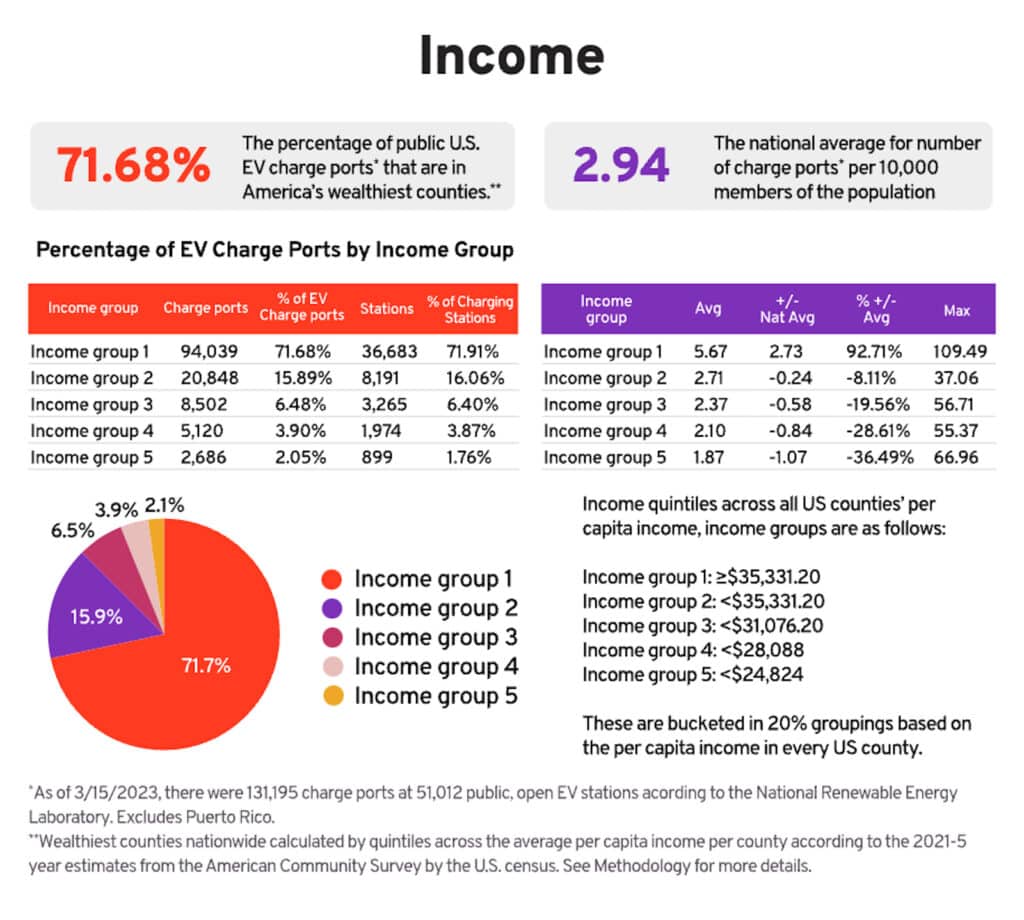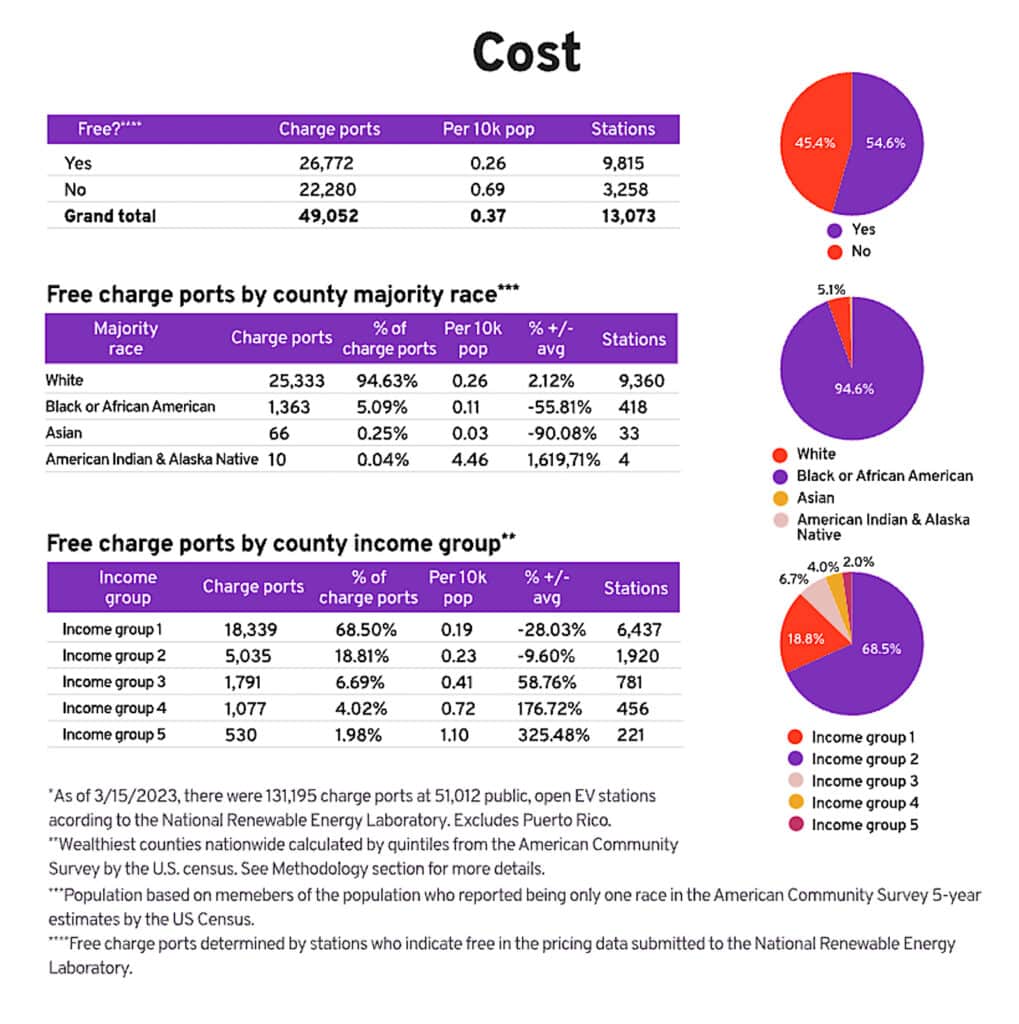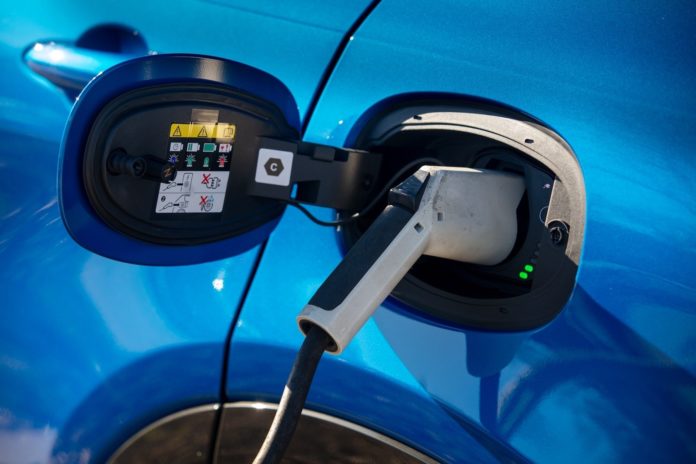It should come as no surprise to anyone who has ever planned a road trip in an EV that charging infrastructure is far from evenly distributed across the United States. However, the extent of the challenge may be news.
According to research by online auto sales and VIN report portal Bumper.com, convenient access to EV chargers is “largely divided by economic and racial lines.” The report goes on to say, “Looking at a range of fiscal and societal factors, our Distressed County Index shows that the top fifth of U.S. counties account for nearly one-third (32.60%) of all EV charge ports in the country.
“The bottom fifth of U.S. counties have access to less than 20% of EV charging stations and charge ports. The divide becomes even more pronounced when we analyze the data by income: More than seven out of every 10 EV charge ports are in the richest U.S. counties.”
Those statistics reflect what anyone can see. EVs have so far been purchased mainly by wealthier individuals with the means to purchase a new vehicle. So charging infrastructure went into those wealthier enclaves, and along major Interstate highway transportation routes. Also predictably, divisions of wealth also reflect racial disparities.
“Our analysis also shows that nearly 95.6% of EV chargers are in counties with majority white populations, compared to 4% in counties with predominantly black populations,” the report reads. “Measured by income groups, the top fifth of US counties for EV charging stations are 80% white and 6.7% black; the bottom fifth is about 70% white and 18% black.”
Efforts to ameliorate these discrepancies are just getting underway, with both government investment, and a new multi-automaker effort to create more charging infrastructure.

“These disparities show the challenges and opportunities the Biden administration faces in expanding the EV charging network nationwide,” according to the report. “Through the Bipartisan Infrastructure Law, $7.5 billion is being invested to build a national EV recharging network of 500,000 charging stations. The administration’s goal is for 50% of new vehicles to be electric by 2030.”
Charging equity is a thing
Kerry Sherin, consumer advocate and data analyst for Bumper, sees a way forward that will be more equitable.
“When it comes to EVs, there’s a lot of Federal money available for states to utilize,” she notes. “But there are stipulations like making sure that it’s representative of the entire population of the area and that we are making sure that we’re installing these charging stations and chargers in low income and other underrepresented communities. Because of that, cities can get a lot of that cost paid entirely by the federal government or in grants, which can cover the cost.”
Sherin also sees utility companies and other private money working toward putting charging wherever people live.
“I think Maryland is one of the states that’s leading the way towards EV adoption. They have state grants for homeowners to install chargers in your garage, and also local electric companies are offering their own EV charging stations. So you’re able to get reduced electricity rates if you add a statio to your property, and then you can open it up to public. Say you have an Airbnb or things like that, you can receive additional funds. There are so many different programs and nuances in each state.”

A big hill to climb
However, as of March, the report states, “There were 131,195 charge ports at 51,012 publicly accessible EV charging stations in the 50 states and the District of Columbia, according to data from the National Renewable Energy Laboratory.
“Charge ports are to EV charging stations what gas pumps are to gas stations, indicating how many electric cars can charge at any one time. The average publicly accessible EV charging station has 2.57 ports, according to government data. Of the 3,143 counties and county equivalents in the US, 63.50% (1,997 counties) have public EV charging stations. The remaining 1,146 US counties (36.50%) currently do not.”
Sherin’s answer is that it will take efforts from all sides to bring charging infrastructure up to the level needed to support widespread EV adoption.
“I think the issue can be approached with a multi-prong strategy,” she said. “Local businesses, city governments, county governments, state governments, the Federal government, and consumers all coming together to support the cause and raise awareness of the issue.
“To further adoption, we have to make sure that charging stations are not only distributed right in the center of town, but towards the outskirts and further out into more rural areas where you find these underrepresented communities. Those are the folks who are lacking access to EV charging stations.”

